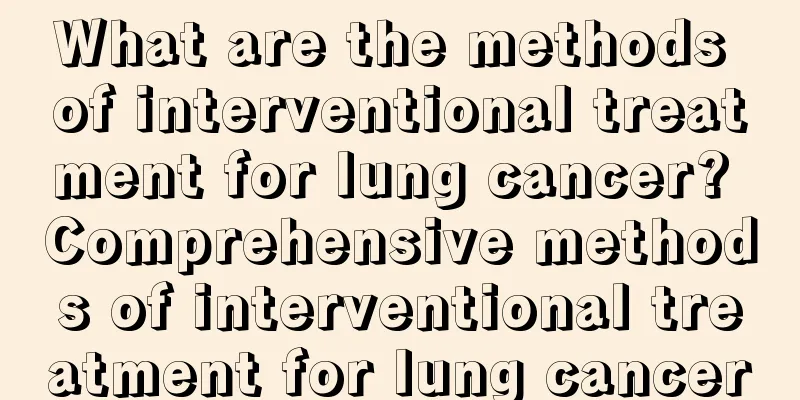What are the methods of interventional treatment for lung cancer? Comprehensive methods of interventional treatment for lung cancer

|
Lung cancer is one of the most common systemic malignant tumors, which seriously threatens human health and life. Its causes and mechanisms are not yet fully understood. At present, the treatment of lung cancer is still a comprehensive treatment with surgery as the main method. However, based on the biological characteristics of lung cancer cells and the non-specific clinical manifestations of lung cancer, about 3/4 of lung cancer patients are already in the middle and late stages when diagnosed, and lose the opportunity for surgery. The adverse reactions caused by simple radiotherapy and chemotherapy are relatively large. Therefore, interventional treatment of lung cancer came into being. The following is a brief introduction to several interventional treatment methods for lung cancer: 1. Intravascular Intervention 1. Pulmonary artery infusion chemotherapy (pAI): pAI not only acts directly on the local tumor, but also can reach the lymph nodes in the hilum, mediastinum, etc., which is very beneficial to the patient's prognosis. 2. Interventional treatment with floating catheter placement in the pulmonary artery: This method has definite efficacy, less pain for patients and low cost, but there are problems such as catheter displacement, drug box flipping or chemotherapy drug blockage, which makes it impossible for the floating catheter to remain in the body for a long time. 3. Subcutaneous drug box implantation system chemotherapy: This method avoids the shortcomings of repeated puncture and intubation, irregular treatment, and hasty injection time. It can be injected regularly and repeatedly, and is a permanent or semi-permanent route of drug administration. 2. Non-vascular interventional therapy 1. Laser therapy: Currently, the lasers used to treat lung cancer are mainly carbon dioxide laser and neodymium-doped yttrium aluminum garnet (Nd-YAG) laser. Laser can convert light radiation energy into cutting, gasification and coagulation, resulting in cell structure destruction and separation of tissue layers. 2. Argon-helium cryotherapy: Argon-helium cryotherapy works by rapidly cooling tissue cells, freezing them, and thawing and rewarming them. Argon-helium cryotherapy is effective in controlling local tumors, and can be effectively combined with other local and systemic treatments to improve long-term efficacy. 3. Percutaneous pulmonary puncture intratumoral anhydrous alcohol injection (pEI): This is a commonly used method for treating solid tumors. Anhydrous alcohol is injected into the tumor to directly act on tumor cells, causing them to coagulate, degenerate, and necrotize. The efficacy of pEI alone for lung cancer is limited, and it is currently used in combination with BAI. 4. Percutaneous lung puncture and intratumoral injection of local chemotherapy: After puncturing into the solid tumor under the guidance of CT or B-ultrasound, chemotherapy drugs are injected locally, and the tumor is directly killed by the diffusion of local high-concentration chemotherapy drugs. This method is more effective for peripheral lung cancer with a diameter of <2cm. However, the drug is easily blocked by the fiber partition inside the diseased tissue, which limits the diffusion range and affects the efficacy. 3. Percutaneous CT-guided radioactive particle implantation: This method uses radioactive particles to continuously irradiate the local tumor with low-dose radiation to directly inhibit the mitosis of tumor cells. Since the particle radioactivity is small, the local tumor irradiation lasts for a long time, the killing power to tumor cells is strong, and the dose outside the tumor range is sharply reduced, which reduces the damage to the surrounding normal tissues and can preserve the lung function to the maximum extent. |
>>: Why do liver cancer patients sweat? How can liver cancer patients with sweating be solved?
Recommend
Improper sitting posture can cause "computer neck". Adjusting the height of desks and chairs can prevent it
People who use computers or work at a desk for a ...
What are the dangers of wearing panty liners for a long time?
Panty liners are small in size, easy to use, and ...
What can help sleep
Sleep is particularly important to the human body...
The correct way to apply lemon slices on your face
When thinking of lemons, most people will start t...
Is it okay to take a bath every day
Taking a bath is a good lifestyle habit. Taking a...
What tests can rule out polycystic ovary
We are bound to encounter some bad things in life...
What to do if calf tendon is strained
If you strain your calf tendon, you can apply ice...
How to increase gastrointestinal motility
Many people have poor gastrointestinal motility. ...
Indications for temporary cardiac pacemaker
There are two types of pacemakers: temporary pace...
What should be paid attention to in the daily care of tongue cancer
The tongue is an important part of our body. Many...
The difference between body shaping and weight loss
As people's living standards continue to impr...
How do women drink red wine
Red wine is generally seen as a symbol of eleganc...
What foods should not be eaten to prevent liver cancer? Don't eat these snacks to prevent liver cancer
In April this year, a 5-year-old girl died of liv...
Effects and functions of orange peel pillow
Orange is actually a very common fruit in our liv...
Can congenital hydrocephalus be cured? What are the treatments?
Congenital hydrocephalus is something none of us ...









